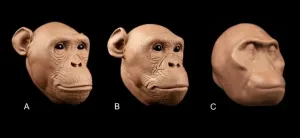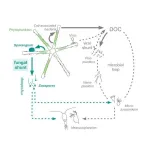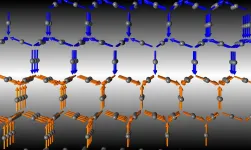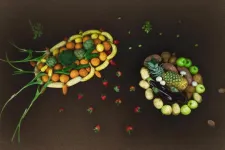Soft tissue measurements critical to hominid reconstruction
2021-06-04
(Press-News.org) Accurate soft tissue measurements are critical when making reconstructions of human ancestors, a new study from the University of Adelaide and Arizona State University has found.
"Reconstructing extinct members of the Hominidae, or hominids, including their facial soft tissue, has become increasingly popular with many approximations of their faces presented in museum exhibitions, popular science publications and at conference presentations worldwide," said lead author PhD student Ryan M. Campbell from the University of Adelaide.
"It is essential that accurate facial soft tissue thickness measurements are used when reconstructing the faces of hominids to reduce the variability exhibited in reconstructions of the same individuals."
Hominids have been readily accepted to line the halls of even the most trusted institutions. They are predominantly used for disseminating scientific information to the public in museum displays and students in university courses, which will influence the way humanity is perceived and defined more generally.
"Up until now soft tissue reconstruction has been based on mean tissue depth measurements which does not take into account variation in tissue depths between individuals," says Mr Campbell.
In this study, published in the journal PLOS ONE, the authors have formulated a facial soft tissue thickness dataset for adult chimpanzees, and a set of regression equations that can be used to reconstruct the soft tissues for ancient hominids, such as those dated from 4.0 to 1.2 million years ago.
The study was co-authored by Gabriel Vinas, a Master of Fine Arts candidate at Arizona State University who handles the sculpting in the lab.
"Correlations have been found and multiple regression models have been used to generate equations for improving estimations of soft tissue thickness from craniometrics in modern humans," he said.
"We looked at tissue depths in present day chimpanzees to identify correlations in skin and bone."
This article represents the first time that such a collection of tissue depth data has been collected and presented for chimpanzees in a systematic manner.
"The soft tissue thickness data for chimpanzees are freely available for anyone to download on Figshare.
"The equations, which resulted directly from this research, are also included and can be implemented in future practitioners' reconstructions," said Mr Campbell.
"This research is invaluable for future efforts reconstructing ancient hominids, as well as for comparative studies within and outside the discipline of biological/physical anthropology."
INFORMATION:
[Attachments] See images for this press release:

ELSE PRESS RELEASES FROM THIS DATE:
2021-06-04
A new study shows that substantial amounts of carbon dioxide were released during the last millennium because of crop cultivation on peatlands in the Northern Hemisphere.
Only about half of the carbon released through the conversion of peat to croplands was compensated by continuous carbon absorption in natural northern peatlands.
Peatlands are a type of wetland which store more organic carbon than any other type of land ecosystem in the world.
Due to waterlogged conditions, dead plant materials do not fully decay and carbon accumulates in peatlands over thousands of years.
Therefore, natural peatlands help to cool the climate by capturing carbon dioxide (CO2) from the atmosphere ...
2021-06-04
ABSTRACT #9003
HOUSTON - Results from the Phase II cohort of the CodeBreaK 100 study showed that treatment with the KRAS G12C inhibitor sotorasib achieved a 37.1% objective response rate and 12.5 months median overall survival in previously treated patients with KRAS G12C-mutated non-small cell lung cancer (NSCLC), according to researchers from The University of Texas MD Anderson Cancer Center. The findings were presented today at the 2021 American Society of Clinical Oncology (ASCO) Annual Meeting and published in the New England Journal of Medicine.
Trial results indicated the targeted therapy was safe and tolerable in a heavily pre-treated patient population. The reported findings make sotorasib the first KRAS G12C inhibitor to demonstrate overall survival benefit in a registrational ...
2021-06-04
A research group of the Department of Pharmacy and Biotechnology of the University of Bologna analyzed more than one million SARS-CoV-2 genome sequences. This analysis led to the identification of a new variant that, over the past weeks, has been spreading mostly in Mexico but has also been found in Europe. Their paper published in the Journal of Medical Virology presented the so-called "Mexican variant", whose scientific name is T478K. Like other strains, this presents a mutation in the Spike protein, which allows coronaviruses to attach to and penetrate their targeted cells.
"This variant has been increasingly spreading among people in North America, particularly in Mexico. To date, this variant covers more than 50% of the existing viruses in this area. The ...
2021-06-04
Tiny algae in Earth's oceans and lakes take in sunlight and carbon dioxide and turn them into sugars that sustain the rest of the aquatic food web, gobbling up about as much carbon as all the world's trees and plants combined.
New research shows a crucial piece has been missing from the conventional explanation for what happens between this first "fixing" of CO2 into phytoplankton and its eventual release to the atmosphere or descent to depths where it no longer contributes to global warming. The missing piece? Fungus.
"Basically, carbon moves up the food chain in aquatic environments differently than we commonly think it does," said Anne Dekas, an assistant professor of Earth system science at Stanford University. Dekas is the senior ...
2021-06-04
Though it might seem inanimate, the soil under our feet is very much alive. It's filled with countless microorganisms actively breaking down organic matter, like fallen leaves and plants, and performing a host of other functions that maintain the natural balance of carbon and nutrients stored in the ground beneath us.
"Soil is mostly microorganisms, both alive and dead," says END ...
2021-06-04
Like all metals, silver, copper, and gold are conductors. Electrons flow across them, carrying heat and electricity. While gold is a good conductor under any conditions, some materials have the property of behaving like metal conductors only if temperatures are high enough; at low temperatures, they act like insulators and do not do a good job of carrying electricity. In other words, these unusual materials go from acting like a chunk of gold to acting like a piece of wood as temperatures are lowered. Physicists have developed theories to explain this so-called metal-insulator transition, but the mechanisms behind the transitions are not ...
2021-06-04
There's a lot of interest right now in how different microbiomes--like the one made up of all the bacteria in our guts--could be harnessed to boost human health and cure disease. But Daniel Segrè has set his sights on a much more ambitious vision for how the microbiome could be manipulated for good: "To help sustain our planet, not just our own health."
Segrè, director of the END ...
2021-06-04
A new drug reduced tumor size in patients who have lung cancer patients with a specific, disease-causing change in the gene KRAS, a study found.
The results of the CODEBREAK 100 phase 2 clinical trial were presented June 4, 2021, at the American Society of Clinical Oncology (ASCO) annual meeting and published simultaneously in the New England Journal of Medicine. The efficacy and safety of the drug sotorasib, developed by Amgen Inc., was tested in patients with non-small-cell lung cancer (NSCLC) harboring a specific change, or mutation, in the DNA code for KRAS.
The KRAS mutant protein targeted in the study was p.G12C, in which a glycine building ...
2021-06-04
Washington, DC--A team led by Carnegie's Thomas Shiell and Timothy Strobel developed a new method for synthesizing a novel crystalline form of silicon with a hexagonal structure that could potentially be used to create next-generation electronic and energy devices with enhanced properties that exceed those of the "normal" cubic form of silicon used today.
Their work is published in Physical Review Letters.
Silicon plays an outsized role in human life. It is the second most abundant element in the Earth's crust. When mixed with other elements, it is essential for many construction and infrastructure projects. And in pure elemental form, it ...
2021-06-04
A study of more than 1,000 demographically representative participants found that about 22 percent of Americans self-identify as anti-vaxxers, and tend to embrace the label as a form of social identity.
According to the study by researchers including Texas A&M University School of Public Health assistant professor Timothy Callaghan, 8 percent of this group "always" self-identify this way, with 14 percent "sometimes" identifying as part of the anti-vaccine movement. The results were published in the journal Politics, Groups, and Identities.
"We found these results both surprising and concerning," Callaghan said. "The fact that 22 percent of Americans at least sometimes identify as anti-vaxxers was much higher than expected and demonstrates ...
LAST 30 PRESS RELEASES:
[Press-News.org] Soft tissue measurements critical to hominid reconstruction




